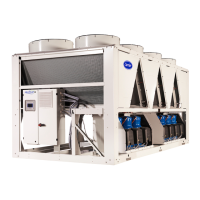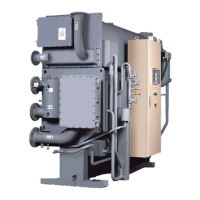Do you have a question about the Carrier 16JT Series and is the answer not in the manual?
Describes the fundamental working principle of the chiller.
Details the efficiency improvement method used.
Describes the physical components and vessels of the chiller.
Covers different methods for starting and stopping the machine.
Details the components and layout of the main control interface.
Step-by-step guide for initiating machine operation.
Step-by-step guide for stopping the machine normally.
Explains procedures for shutdowns due to safety device activation.
Describes the system managing machine output based on load.
Details the electronic component controlling the valve.
Lists necessary specifications, sheets, and tools for setup.
Verifies installation and specifications of piping and wiring.
Safety precautions and procedures for the primary solution.
Steps for adding the correct amount of refrigerant.
Steps to prepare and power the control system.
Verifies proper operation of pump motor starters.
Ensures the safety device functions correctly.
Initial verification steps before system startup.
Procedures for setting the correct refrigerant level.
Responsibilities and tasks for the operator.
Pre-operation checks and conditions.
General guidance for initiating machine operation.
Steps for safely stopping the machine normally.
Specific procedures for shutdown in freezing conditions.
Routine inspections and data logging.
Scheduled maintenance intervals for checks and analysis.
How to manually vent the purge system.
Method for measuring absorber performance.
Steps to find and fix leaks and remove gases.
Methods for drawing fluid samples for analysis.
Interpreting sample results and maintaining inhibitor levels.
Procedure for adding octyl alcohol to the solution.
Steps for refrigerant level and temperature switch calibration.
Detailed checks of pump parts after disassembly.
Steps for taking apart components, specifically pumps.
Detailed checks of pump parts for wear or damage.
Steps for putting pump components back together.
Procedures to resolve crystallized solution issues.
Addresses scale formation in condenser tubes.
Identifies causes and remedies for startup failures.
Addresses issues with high, low, or fluctuating temps.
Diagnoses problems related to purging and solution crystallization.
Addresses abnormal pump noises and Cycle-Guard operation.
Describes the fundamental working principle of the chiller.
Details the efficiency improvement method used.
Describes the physical components and vessels of the chiller.
Covers different methods for starting and stopping the machine.
Details the components and layout of the main control interface.
Step-by-step guide for initiating machine operation.
Step-by-step guide for stopping the machine normally.
Explains procedures for shutdowns due to safety device activation.
Describes the system managing machine output based on load.
Details the electronic component controlling the valve.
Lists necessary specifications, sheets, and tools for setup.
Verifies installation and specifications of piping and wiring.
Safety precautions and procedures for the primary solution.
Steps for adding the correct amount of refrigerant.
Steps to prepare and power the control system.
Verifies proper operation of pump motor starters.
Ensures the safety device functions correctly.
Initial verification steps before system startup.
Procedures for setting the correct refrigerant level.
Responsibilities and tasks for the operator.
Pre-operation checks and conditions.
General guidance for initiating machine operation.
Steps for safely stopping the machine normally.
Specific procedures for shutdown in freezing conditions.
Routine inspections and data logging.
Scheduled maintenance intervals for checks and analysis.
How to manually vent the purge system.
Method for measuring absorber performance.
Steps to find and fix leaks and remove gases.
Methods for drawing fluid samples for analysis.
Interpreting sample results and maintaining inhibitor levels.
Procedure for adding octyl alcohol to the solution.
Steps for refrigerant level and temperature switch calibration.
Detailed checks of pump parts after disassembly.
Steps for taking apart components, specifically pumps.
Detailed checks of pump parts for wear or damage.
Steps for putting pump components back together.
Procedures to resolve crystallized solution issues.
Addresses scale formation in condenser tubes.
Identifies causes and remedies for startup failures.
Addresses issues with high, low, or fluctuating temps.
Diagnoses problems related to purging and solution crystallization.
Addresses abnormal pump noises and Cycle-Guard operation.












